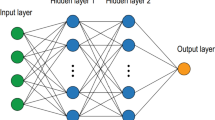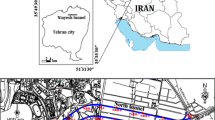Abstract
Construction of embankments in engineering structures on soft clay soils normally encounters problems related to excessive settlement issues. The conventional methods are inadequate to analyze and predict the surface settlement when the necessary parameters are difficult to determine in the field and in the laboratory. In this study, artificial neural network systems (ANNs) were used to predict settlement under embankment load using soft soil properties together with various geometric parameters as input for each stone column (SC) arrangement and embankment condition. Data from a highway project called Lebuhraya Pantai Timur2 in Terengganu, Malaysia, were investigated. The FEM package of Plaxis v8 program analysis was utilized. The actual angle of internal friction, spacing between SC, diameter of SC, length of SC, and height of embankment were used as the input parameters, and the settlement was used as the main output. Non cross validation (NCV) and tenfold cross validation (TFCV) were used to build the ANN model. The results of the TFCV model were more accurate than those of the NCV model. Comparisons made with the predictions of the Priebe model showed that the proposed TFCV model could provide better predictions than conventional methods.









Similar content being viewed by others
References
Aboshi H, Ichimoto E, Enoki M, Proc KH (1979) The compozer-A method to improve characteristics of soft clays by inclusion of large diameter sand columns. In: International conference on soil reinforcement: Reinforced earth and other techniques, Paris. pp 211–216
Arukrajah A, Affendi A (2002) Vibro replacement design of high-speed railway embankments. Paper presented at the 2nd World Engineering Congress, Kuching, Malaysia
Attoh-Okine N (2002) Combining use of rough set and artificial neural network in doweled-pavement performance modelling-a hybrid approach. J Transp Eng (ASCE) 128(3):270–275
Banimahd M, Yasrobi SS, Woodward PK (2005) Artificial neural network for stress–strain behavior of sandy soils: knowledge based verification. Comput Geotech 32:377–386
Barksdale RD, Bachus RC (1983) Design and construction of stone columns, Vol. I, and Vol. II. FHWA/RD-83/026. Federal Highway Administration, Washington
Barksdale RD, Takefumi T (1990) Design, construction and testing of sand compaction piles, symposium on deep foundation improvements: Design Construction and Testing. ASTM Publications, Las Vegas
Beale R, Jackson T (1990) Neural computing: an introduction. Institute of Publishing, Bristol
Bergado DT, Anderson LR, Miura N, Balasubrananiam AS (1996) Improvement of soft Bangkok clay using vertical drains. Geotext Geomembr 12:615–663
Bishop C (1995) Neural networks for pattern recognition. Oxford University Press, New York
Bo MW, Choa V (2004) Reclamation and ground improvement. Thomson Learning, Singapore
Caruana R, Lawrence S, Giles C (2001) Overfitting in neural networks: backpropagation, conjugate gradient, and early stopping. In: Leen TK, Dietterich TG, Tresp V (eds) Advances in Neural Information Processing Systems, vol 13. MIT Press, Cambridge
Choobbasti AJ, Farrokhzad F, Barari A (2009) Prediction of slope stability using artificial neural network (case study: Noabad, Mazandaran, Iran). Arab J Geosci 2(4):311–319. doi:10.1007/s12517-009-0035-3
Cimentada A, Da Costa A, Cañizal J, Sagaseta C (2011) Laboratory study on radial consolidation and deformation in clay reinforced with stone columns. Can Geotech J 48(1):36–52. doi:10.1139/T10-043
Flood I, Kartam N (1994a) Neural network in civil engineering. II: systems and applications. J Comput Civ Eng (ASCE) 8(2):149–162
Flood I, Kartam N (1994b) Neural network in civil engineering. I: principles and understandings. J Comput Civ Eng ASCE 8(2):131–148
Goh A (1994) Seismic liquefaction potential assessed by neural network. J Geotech Eng 120(9):1467–1480
Greenwood DA, Kirsch K (1984) Specialist ground treatment by vibratory and dynamic methods. In: State of the Art Report, Piling and Ground Treatment, Thomas Telford. pp 17–45
Guetif Z, Bouassida M, Debats JM (2007) Improved soft clay characteristics due to stone column installation. Comput Geotech 34(2):104–111. doi:10.1016/j.compgeo.2006.09.008
Haykin S (1998) Neural networks: a comprehensive foundation. Prentice Hall, New Jersey
Haykin S (1999) Neural networks. A comprehensive foundation, 2nd edn. Prentice Hall, Upper Saddle River
Kasa A, Chik Z, Taha MR (2011a) Prediction of external stability for geogrid-reinforced segmental walls. Key Eng Mater 462–463:1319–1324
Kasa A, Chik Z, Taha MR (2011b) Prediction of internal stability for geogrid-reinforced segmental walls. Adv Mater Res 163–167:1854–1857
Kia MB, Pirasteh S, Pradhan B, Mahmud AR, Sulaiman WNA, Moradi A (2011) An artificial neural network model for flood simulation using GIS: Johor River Basin, Malaysia. Environ Earth Sci 67(1):251–264. doi:10.1007/s12665-011-1504-z
Kousik D, Chandra S, Basudhar PK (2008) Response of multilayer geosynthetic-reinforced bed resting on soft soil with stone columns. Comput Geotech 35(3):323–330
Lawrence S, Giles C, Tsoi A Lessons in neural network training: overfitting may be harder than expected. In: the Fourteenth National Conference on Artificial Intelligence, 1997. pp 540–545
Lo SR, Zhang R, Mak J (2010) Geosynthetic-encased stone columns in soft clay: a numerical study. Geotext Geomembr 28(3):292–302. doi:10.1016/j.geotexmem.2009.09.015
Mitchell T (1997) Machine learning. McGraw Hill, Burr Ridge
Olden JD, Joy MK, Death RG (2004) An accurate comparison of methods for quantifying variable importance in artificial neural networks using simulated data. Ecol Model (178:389–397
PLAXIS D-V (2002) In: Brinkgreve RBJ (ed) Finite element code for soil and rock analysis, User manual. Delft University of Technology & Plaxis bv, The Nederlands
Pradhan B, Pirasteh P (2010) Comparison between prediction capabilities of neural network and fuzzy logic techniques for landslide susceptibility mapping. Disaster Adv 3(2):26–34
Priebe HJ (1991) Vibro-replacement – design criteria and quality control. Deep Foundation Improvements Design, Construction and Testing. ASTM STP 1089, ASTM
Priebe HJ (1995) The design of vibro-replacement. In: Proceedings of the Institution of Civil Engineers, Ground Engineering, vol 10. pp 31–37
Rumelhart DE, McClelland JL, Group. TPR (1986) Parallel Distributed Processing: Explorations in the Microstructure of Cognition, vol (Chapter 8) Volume 1. Foundations. MIT Press, Cambridge
Shahin MA, Indraratna B (2006) Modeling the mechanical behavior of railway ballast using artificial neural networks. Can Geotech J 43(11):1144–1152. doi:10.1139/t06-077
Shahin MA, Jaska MB, Maier HR (2002) Predicting settlement of shallow foundation using neural networks. J Geotech Geoenviron Eng ASCE 128(9):785–793
Shahin MA, Maier HR, Jaksa MB (2004) Data division for developing neural networks applied to geotechnical engineering. J Comput Civ Eng (ASCE) 18(2):105–114
Tien Bui D, Pradhan B, Lofman O, Revhaug I, Dick OB (2011) Landslide susceptibility mapping at Hoa Binh province (Vietnam) using an adaptive neuro fuzzy inference system and GIS. Comput Geosci 45:199–211
Tien Bui D, Pradhan B, Lofman O, Revhaug I, Dick OB (2012) Landslide susceptibility assessment in the Hoa Binh province of Vietnam using artificial neural network. Geomorphology 171–172:12–19
Weigend A (1994) On overfitting and the effective number of hidden units. In: Mozer A, Smolensky P, Touretzky DS, Elman JL, Weigend AS (eds) Connectionist Models Summer School. Lawrence Erlbaum Associates, Hillsdale, pp 335–342
Zahmatkesh A, Choobbasti AJ (2010) Settlement evaluation of soft clay reinforced with stone columns using the equivalent secant modulus. Arab J Geosci 5(1):103–109. doi:10.1007/s12517-010-0145-y
Zarea M, Pourghasemi HR, Vafakhah M, Pradhan B (2012) Landslide susceptibility mapping at Vaz watershed (Iran) using an artificial neural network model: a comparison between multilayer perceptron (MLP) and radial basic function (RBF) algorithms. Arab J Geosci. doi:10.1007/s12517-12012-10610-x
Zhou C, Yin J-H, Ming J-P (2002) Bearing capacity and settlement of weak fly ash ground improved using lime, fly ash or stone columns. Can Geotech J 39(3):585–596. doi:10.1139/t02-011
Acknowledgments
The authors would like to thank Universiti Kebangsaan Malaysia (UKM) for GUP-2012-03 research grant in this work and the Department of civil and structural engineering, for the use of computer laboratory.
Author information
Authors and Affiliations
Corresponding author
Rights and permissions
About this article
Cite this article
Chik, Z., Aljanabi, Q.A., Kasa, A. et al. Tenfold cross validation artificial neural network modeling of the settlement behavior of a stone column under a highway embankment. Arab J Geosci 7, 4877–4887 (2014). https://doi.org/10.1007/s12517-013-1128-6
Received:
Accepted:
Published:
Issue Date:
DOI: https://doi.org/10.1007/s12517-013-1128-6




